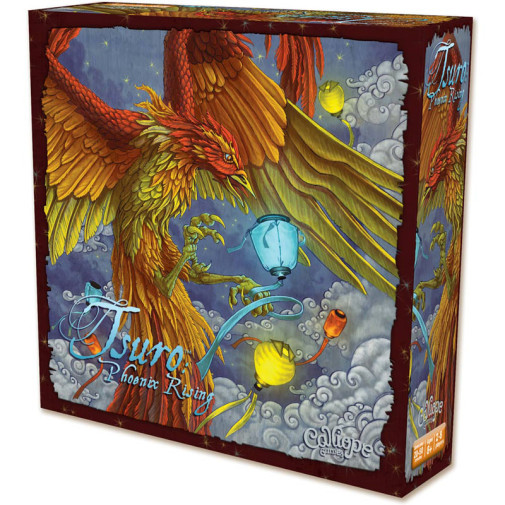We use cookies to make your experience better. To comply with the new e-Privacy directive, we need to ask for your consent to set the cookies. Learn more.
Tsuro: Phoenix Rising Game
In this lightweight puzzle, players move through a changing labyrinth of tiles as a “Phoenix” with the goal of collecting seven stars. Each player also receives one life token that they can use to “rise from the ashes” if their Phoenix player token is forced to follow a path that leads them off the game board. The game begins with the main board being populated by 16 center tiles with various paths that lead in different directions that can be manipulated by turning and flipping the tiles. Among the center tiles are eight glowing lanterns with two each of the four colors being matched and placed on these lanterns. The tiles that will comprise the edges of the board are stacked into a draw pile. Each player receives two edge tiles that they will choose from in order to start moving their Phoenix onto the board. On the first turn, each player will use one of the two starting tiles and place it in the most advantageous way for their Phoenix to enter the labyrinth with a pathway into the labyrinth. They will then return the unused tile to the bottom of the draw pile. In turn order, the other players will begin in the same way. Upon succeeding player turns, each player will either move forward on its existing path by either adding another new tile – if their path leads to an empty area, flipping, or rotating an existing tile if their path leads to another tile that has no path forward. The player’s Phoenix will then travel its path, continuing through as many adjacent tiles as their path leads them. When a player moves through a tile with a lantern piece on it, a star will be placed on that tile. Once their Phoenix has moved to the end of their existing path on that turn, they will move all lanterns that were sitting on tiles that they have completely moved through and collect all stars they placed on those tiles. The game ends when either one player collects seven stars, their Phoenix is moved off the edge of the board and they have used their life token, or there are is no empty space on the edge of the board to place another tile. When the game end triggers, each person who did not have a turn that round will finish his or her last turn. The player with the most stars wins the game! However, a player must either be on the board when the game ends or if they are off the board, they must be in a position to enter the board again by possessing a life token and using empty space on which to re-enter the board their next turn. This is a fun, family game for a wide range of ages. It is quick to learn, but yet contains enough strategy to keep everyone engaged. For 2-8 players, with a 20 to 50-minute playtime that varies based on the player count.
In its simplest form, Tsuro is a curious "last man standing" version of Labyrinth, but the board is empty to begin. The 6x6 grid has a pair of paths leading off from every edge tile; players pick any one of the 48 starting paths and place their piece on it. To begin, each player draws 3 path tiles. Each tile features a twisting variety of paths - some curve to another edge of the tile, some go straight, and some cross between a pair of paths. All of the tiles match up perfectly to every other tile as well as the edge of the board.On your turn, place a tile of your choice at the end of your pawn's path, and then move your pawn (and any opponents connected to that tile) to the very end of the newly-extended path. Beware: if your path now extends to the edge of the board, or forces you to run in to another pawn, you're out! Since all of the paths will ultimately lead to the edge of the board as the tiles keep being played, it's only a matter of time... at which point the last player left on the board wins! Easy to learn and suitable for (almost) all ages, Tsuro is an excellent "light strategy" game for friends and families alike. 2-8 players; ~15 minute play-time. Cited by Psychology Today as a helpful resource for autism spectrum disorders (ASD).
| Product Format: | Other |
|---|---|
| Brand: | Calliope Games |
| Grades: | 3-AD |
| EAN/UPC: | 845866001200 |
| Length in Inches: | 9.375 |
| Width in Inches: | 9.5 |
| Height in Inches: | 2.875 |
| Weight in Pounds: | 2.35 |

